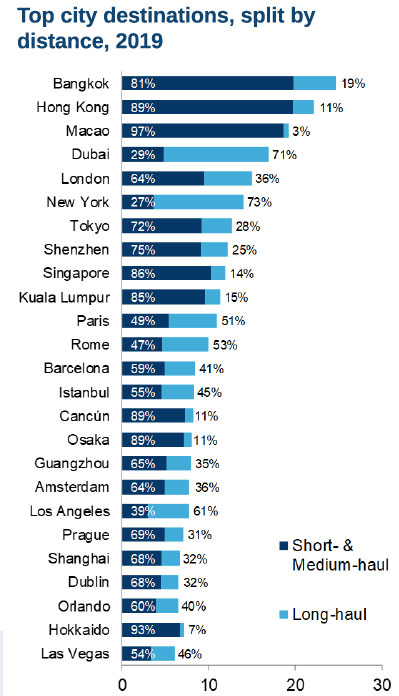How impactful is transportation for the environment? What is the impact of city traveling? How much more will people be traveling over the next years? What cities will have the largest number of visitors in the future? From which ones are most international travelers coming from? Why are there increasingly more people traveling and what can we do about it?
As you’re probably aware, transportation is responsible for 14% of greenhouse gas emissions. Among others, transportation is meant to serve human needs of getting fed (so we ship food), entertained (so we ship gadgets), discovering the world (so we move around), among others. The OECD predicts that in 2050, 68% of the world’s population will be living in cities and urban areas, compared to 55% today. In this way, it’s important to analyse transportation from a cities perspective, as it’s where most products/services/people will move around, either arriving or leaving.
We might tend to think of the ecological/social impact of cities from a perspective of how much local people pollute by driving their cars to work instead of commuting or how rents are becoming very expensive in city centers and how that affects neighborhood inequality and quality of life. However, when we consider not only the people living full-time in cities but also the ones visiting, a new perspective regarding the ecological and social impacts of cities comes to life.
City travel is set to increase by 27% by 2025 as cities work both as the origin (where most people with an income high enough to travel are) and destination markets. Which cities and regions are most visited nowadays? And which ones will have the highest growth until 2025? How can we avoid pollution from transportation, from a visitor’s perspective?
- Related:
Which Cities Are Getting the Largest Number of Visitors and Money Spent in 2019

To analyze the flux of people flying and the number of visitors in the world’s main cities, we took a deep look at the Oxford Economics, Global City Travel 2019 Report. According to it, 630 million international visitors are expected to visit the top 300 cities worldwide in 2019, an additional 28 million will travel to compared to 2018. And they’ll arrive using all transportation means, from planes to cars, buses or trains. Moreover, these cities will account for almost 50% of global international visitor arrivals in 2019, while being home to just 20% of the world’s population.
Among the top 25 cities getting the largest number of visitors in 2019, 11 are Asian cities. Bangkok comes first with 24.6 mn, followed by Hong Kong (22.1mn) and Macau (19.2mn). These cities are highly reliant on short and medium-haul travel, benefiting from the growth of China’s economy and middle-class. After Asia, Europe is the second most represented continent with 8 out of the top 25 destinations. Among these, London remains the most popular European city for international arrivals.
When it comes to global travel expenditure, numbers are expected to grow ~6% in 2019 compared to 2018, reaching $1,5 trillion. Of course, spending patterns are different depending on the city. And the top 5 destinations for international spending are Macau ($39bn), Hong Kong ($27bn), New York ($26bn), Bangkok ($22bn) and Shenzhen ($22bn). And in destinations such as London, Paris or Rome, spendings are expected to go up to $15bn, $10,9bn and $8,9bn, respectively.
Which Cities Will Get the Largest Number of Visitors and Money Spent in 2025
Though they already get a great number of visitors today, forecasts from Oxford Economics’ Global City Travel 2019 Report are that all the top 25 cities will see their number of visitors grow by 2025. Among the ones growing the most, Asian cities are again in the sweet spot, more specifically Kuala Lumpur (7,7% growth), Macau and Istanbul (5,7%), Guangzhou (4,9%) Dubai (4,8%) and Shenzhen (4,7%).
If we leave Asia behind, the cities in Europe and America likely to grow the most are London and New York, with a 3,3% each in 2025 compared to 2019. Other European cities such as Paris, Rome, Barcelona or Prague will also see a small growth and they’ll remain in the top 25 most visited cities worldwide.
Which Cities Send More Visitors
One-third of the growth in international visitor arrivals between 2019 and 2025 will come from China, the US, and the UK. Furthermore, by 2025, an extra 27 million visitors are expected to travel from the main cities of China to the top 300 most visited cities in the world.
The US and the UK follow as the largest markets of travelers, from which a combined number of 25 million international visitors will come from in 2025. In fact, the US accounts today, on average, for 10,8% of the total departures to the main European cities analyzed by Oxford Economics’ Report, a percentage that grows up to 17% if we think of visitors going to Paris’ or to 14% going to London or Barcelona.
Moreover, European cities account for 12 of the top 25 cities for international departures in 2019, with London (16.3mn) being the largest European city for international departures and the 2nd worldwide, only losing ground to Hong Kong (39.9mn). Singapore (11,2mn), Macau (6,2mn), Toronto (6mn), Abu Dhabi and Seoul (5,8mn), Berlin (5,5mn), Moscow (5,3) and New York (4,9mn) make up the top 10 cities from where international visitors depart.
What’s Behind the Increases in the Flows Of People

Here’s some food for thought that can help explain why traveling is expected to grow so much over the next years. One has to do with the increasing desire to travel the world. If we take a look at Deloitte’s study on the behaviors and priorities of the new generations, it says having children, buying homes, and other traditional signals of adulthood “success markers” do not top their (millennials and Gen Zs) list of ambitions. Instead, on top of their aspirations lists are traveling and seeing the world. Humakind’s desire to explore new places has always been around, and seems like it will continue to.
At the same time, it’s interesting to bear in mind too that only in the 19th century the human population got to 1 billion, and that only in 1960 we got to 3 billion people inhabiting the planet. Today, as this piece is being written, the world had (just a few seconds ago) 7,726,737,890 people inhabiting it. So it’s not just about desire, it’s also that we’re a lot more people sharing this desire today compared to 60 years ago.
Moreover, as the economy grew over the last decades, wealth grew too (although it’s distribution is hugely unequal), making it easier for people to afford traveling. In fact, a Trends Shaping Education 2019 OECD Report says that between 2000 and 2030, China’s economy and share of the global middle class is expected to grow from 1% to 22% (relative shares), slightly more than India’s forecast (from 1% to 17%). That’s why raising awareness in these regions of the globe regarding the importance of sustainable development is so important. Ultimately, it’s not just that there’s a lot of people sharing the desire to travel, it’s also that there are more people who can afford to do it.
Another reason contributing to this increase in the number of people traveling has to do with the fact that transportation is way more affordable nowadays. Buses are cheaper, renting a car is easy thanks to smartphones and the air transportation industry is particularly cheaper – due to liberal air regulations and the rise of low cost carries that facilitated the expansion of air networks. Although trains and buses are more eco-friendly than planes, they’re often slower and more expensive (especially trains) – reasons people often evoke to justify why they keep on flying. More people with the money and desire to travel who can do it at affordable prices. That’s something, right?
Should We Be Travelling Around This Much? What Can Be Done?
Should we? How subject can this question be? Maybe it depends on the scenario we use to analyse this question? Some people travel a lot due to the nature of their jobs, as is the case with many international consultants from all sectors. Others are immigrant workers coming to developed countries to send more money back to their families in their countries of origin – and end up contributing to the development of these economies. In fact, between 1990 and 2017, the total number of international migrant stock grew 69%, i.e., from 153 to 258 million people and international migrants account for 3% of the world’s population.
What about a scenario of free time or enjoying holidays? Should the people who spend so much time working, often performing jobs they don’t necessarily enjoy, be discouraged from escaping for 20-40 days out of 365 to do whatever they feel like doing? What about Millenials and Gen Zers who are eager to travel the world, meet new cultures, new people, new parties and new remote job opportunities possible thanks to the digital world – should they be asked to stop traveling or to travel less often?
While there are probably no black or white answers to these questions, there’s certainly a mindset that needs to be adopted for the long term balance of our planet to be possible: a sustainability mindset. And you can find some examples of how this mindset can come to live in our article: How To Convince People To Be More Eco-Friendly In How They Move Around.
Image credits to tourists on Shutterstock, traveler on Shutterstock and happy on Shutterstock

